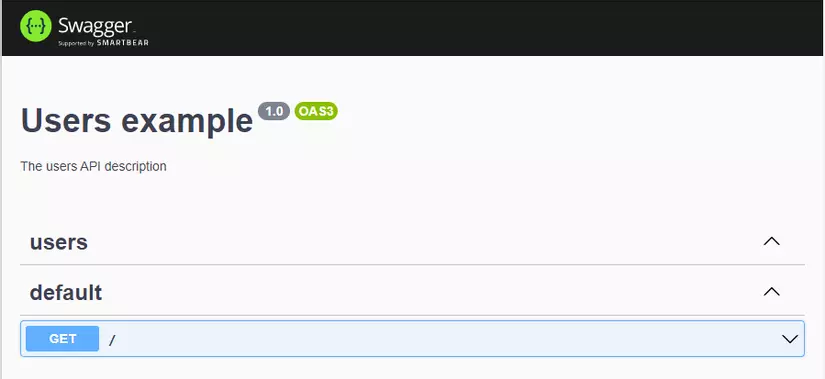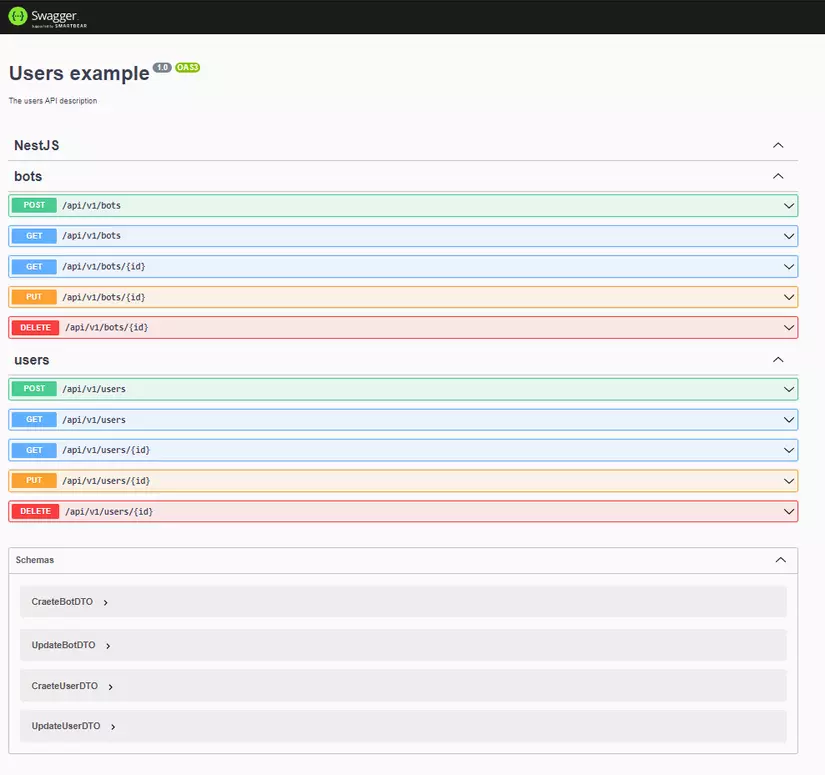I. Mở đầu
- Trong các bài viết về nestjs mình toàn chỉ dùng Graphql nên hôm nay đổi gió một chút, giới thiệu các bạn về restAPI sử dung swaggerUI trong nestjs
- Trong bài viết này mình sử dung yarn thay vì npm
II. Cài đặt
- dùng
nest new <project name>để tạo project nest - dùng lệnh bên dưới để cài swagger
yarn add @nestjs/swagger swagger-ui-express - thêm
"skipLibCheck": truetrongtsconfig.jsonđể bỏ qua việc check tslint trong node_module, nếu bị bắt lỗi những file trong node_module - khi bạn gặp lỗi
Error: Cannot find module '@nestjs/core/router/route-path-factory'thì do bị lỗi phiên bản tương thích: https://github.com/nestjs/nest/issues/7499#issuecomment-877050501 - cách để sửa lỗi
trong file main.ts sửa code lại thành như bên dưới để khi run thì có swagger
import { NestFactory } from '@nestjs/core';
import { SwaggerModule, DocumentBuilder } from '@nestjs/swagger';
import { AppModule } from './app.module'; async function bootstrap() { const app = await NestFactory.create(AppModule); const config = new DocumentBuilder() .setTitle('Cats example') .setDescription('The cats API description') .setVersion('1.0') .addTag('cats') .build(); const document = SwaggerModule.createDocument(app, config); SwaggerModule.setup('api', app, document); await app.listen(3000);
}
bootstrap();
-
yarn start:devrồi vào linkhttp://localhost:3000/api/#/sẽ ra giao diện như bên dưới
III. Sử dụng TypeOrm
yarn add @nestjs/typeorm typeorm postgres pgđể cài SQL sử dụng- thêm vào
package.jsontrong phầnscripts2 câu lệnh dưới để generate file migrate"m:g": "yarn build && typeorm migration:generate -n", "m:run": "yarn build && typeorm migration:run", - tạo 1 file tên là
ormconfig.jsđể typeorm tự động nhận các config trong nàyconst DBConfig = { type: 'postgres', host: 'localhost', port: 5432, username: 'postgres', password: '1', database: 'TEST_SWAGGER', entities: ['dist/**/*.entity.js'], migrations: ['dist/databases/migrations/*.js'], cli: { migrationsDir: 'src/databases/migrations' }, synchronize: false, } module.exports = DBConfig; - trong
app.module.tsthì thêmTypeOrmModule.forRoot()và xóacontrollerslẫnproviders, vì chúng ta sẽ import các module vào nên chỗ này k cần thiết nữa
import { Module } from '@nestjs/common';
import { TypeOrmModule } from '@nestjs/typeorm';
import { AppController } from './app.controller';
import { AppService } from './app.service'; @Module({ imports: [ TypeOrmModule.forRoot() ]
})
export class AppModule {}
- tạo folder tên
bots, tạm thời gồm 2 filebot.entity.tsimport { Column, Entity, PrimaryGeneratedColumn } from 'typeorm'; @Entity('bots') export class BotEntity { @PrimaryGeneratedColumn() id: number; @Column({ length: 500 }) name: string; @Column('text') description: string; }bot.module.tsimport { Module } from '@nestjs/common'; import { TypeOrmModule } from '@nestjs/typeorm'; import { BotEntity } from './bot.entity'; @Module({ imports: [ TypeOrmModule.forFeature([BotEntity]), ], providers: [], }) export class BotModule { }- chạy lệnh
yarn m:g create-bot-entityvàyarn m:run, để tạo file migratecreate-bot-entityvà run luôn file đó để tránh khi tạo file migrate mới sẽ generate ra code cũ của file entity khác
- tạo folder tên
users, tạm thời chứa 2 fileuser.entity.tsimport { Entity, Column, PrimaryGeneratedColumn } from 'typeorm'; @Entity() export class User { @PrimaryGeneratedColumn() id: number; @Column() firstName: string; @Column() lastName: string; @Column({ default: true }) isActive: boolean; }user.module.tsimport { Module } from '@nestjs/common'; import { TypeOrmModule } from '@nestjs/typeorm'; import { UserEntity } from './user.entity'; @Module({ imports: [ TypeOrmModule.forFeature([UserEntity]), ], providers: [], }) export class BotModule { }- chạy lệnh
yarn m:g create-bot-entityvàyarn m:run
- Nếu bạn gặp lỗi
TypeError: rxjs_1.lastValueFrom is not a functionthì chạy lệnhyarn add _@.com^7 - tạo 1 folder tên databases với các file sau
database.provider.ts(lưu ýsynchronize: truekhông được dùng khi lên product vì sẽ dễ mất dữ liệu)import { createConnection } from 'typeorm'; export const databaseProviders = [ { provide: 'DATABASE_CONNECTION', useFactory: async () => await createConnection({ type: 'postgres', host: 'localhost', port: 5432, username: 'postgres', password: '1', database: 'TEST_SWAGGER', entities: [ __dirname + '/../**/*.entity{.ts,.js}', ], synchronize: false, }), }, ];database.module.tsimport { Module } from '@nestjs/common'; import { databaseProviders } from './database.provider'; @Module({ providers: [...databaseProviders], exports: [...databaseProviders], }) export class DatabaseModule {}
- tạo 2 file
user.provider.tsimport { Connection } from 'typeorm'; import { UserEntity } from './user.entity'; export const userProvider = [ { provide: 'USER_REPOSITORY', useFactory: (connection: Connection) => connection.getRepository(UserEntity), inject: ['DATABASE_CONNECTION'], }, ];bot.provider.tsimport { Connection } from 'typeorm'; import { BotEntity } from './bot.entity'; export const botProvider = [ { provide: 'BOT_REPOSITORY', useFactory: (connection: Connection) => connection.getRepository(BotEntity), inject: ['DATABASE_CONNECTION'], }, ];
- thay đổi 2 file là
bot.module.tsimport { Module } from '@nestjs/common'; import { TypeOrmModule } from '@nestjs/typeorm'; import { DatabaseModule } from 'src/databases/database.module'; import { BotEntity } from './bot.entity'; import { botProvider } from './bot.provider'; @Module({ imports: [ TypeOrmModule.forFeature([BotEntity]), DatabaseModule, ], providers: [...botProvider], }) export class BotModule { }user.module.tsimport { Module } from '@nestjs/common'; import { TypeOrmModule } from '@nestjs/typeorm'; import { DatabaseModule } from 'src/databases/database.module'; import { UserEntity } from './user.entity'; import { userProvider } from './user.provider'; @Module({ imports: [ TypeOrmModule.forFeature([UserEntity]), DatabaseModule, ], providers: [...userProvider], }) export class UserModule { }
IV. Sử dụng SwaggerUI
-
Ok! trước khi tới phần controller và service, ta phải tạo ra DTO (data to object) trước. File DTO này sẽ có nhiệm vụ là bắt validate và tạo property trong swagger
-
create-bot.dto.tsimport { ApiProperty } from '@nestjs/swagger'; export class CraeteBotDTO { @ApiProperty() id: number; @ApiProperty() name: string; @ApiProperty() description: string; } -
update-bot.dto.tsimport { PartialType } from '@nestjs/swagger'; import { CraeteBotDTO } from './create-bot.dto'; export class UpdateBotDTO extends PartialType(CraeteBotDTO) { } -
tương tự cho user
-
Giờ là lúc tạo controller và service
-
file
bot.controller.tsimport { Body, Controller, Delete, Get, Param, Post, Put } from '@nestjs/common'; import { ApiOkResponse, ApiTags } from '@nestjs/swagger'; import { BotService } from './bot.service'; import { CraeteBotDTO } from './create-bot.dto'; import { UpdateBotDTO } from './update-bot.dto'; @ApiTags('bots') @Controller('bots') export class BotController { constructor( private botSerivce: BotService, ) { } @Post() createOneBot(@Body() createBotDTO: CraeteBotDTO) { return this.botSerivce.createOneBot(createBotDTO); } @Get() @ApiOkResponse({ description: 'List all bots' }) async getBotList() { return await this.botSerivce.getBotList(); } @Get(':id') getDetailBot(@Param('id') id: number) { return this.botSerivce.getDetailBot(id); } @Put(':id') updateBot(@Param('id') id: number, @Body() updateBotDTO: UpdateBotDTO) { return this.botSerivce.updateBot(id, updateBotDTO); } @Delete(':id') removeOneBot(@Param('id') id: number) { return this.botSerivce.removeOneBot(id); } } -
file
bot.service.tsimport { Inject, Injectable } from '@nestjs/common'; import { Repository } from 'typeorm'; import { BotEntity } from './bot.entity'; import { CraeteBotDTO } from './create-bot.dto'; import { UpdateBotDTO } from './update-bot.dto'; @Injectable() export class BotService { constructor( @Inject('BOT_REPOSITORY') private readonly botRepository: Repository<BotEntity>, ) { } createOneBot(createBotDTO: CraeteBotDTO) { return this.botRepository.save(createBotDTO); } getBotList() { return this.botRepository.find({}); } getDetailBot(id: number) { return this.botRepository.findOne(id); } updateBot(id: number, updateBotDTO: UpdateBotDTO) { return this.botRepository.update(id, updateBotDTO); } removeOneBot(id: number) { return this.botRepository.delete(id); } } -
tương tự cho user
-
Xém quên mất, bên trong 2 module phải thêm controller nếu không sẽ k có hiện được các api
